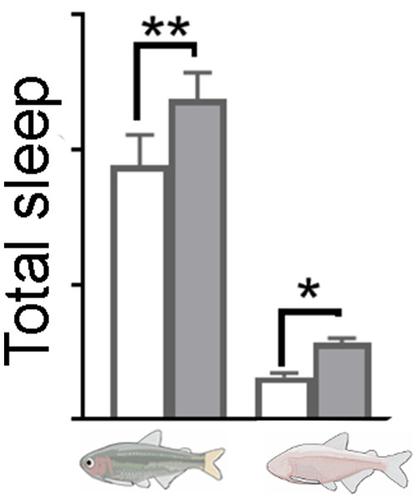当前位置:
X-MOL 学术
›
J. Exp. Zool. B Mol. Dev. Evol.
›
论文详情
Our official English website, www.x-mol.net, welcomes your feedback! (Note: you will need to create a separate account there.)
Unique transcriptional signatures of sleep loss across independently evolved cavefish populations.
Journal of Experimental Zoology-B: Molecular and Developmental Evolution ( IF 2.2 ) Pub Date : 2020-04-29 , DOI: 10.1002/jez.b.22949 Suzanne E McGaugh 1 , Courtney N Passow 1 , James Brian Jaggard 2 , Bethany A Stahl 2 , Alex C Keene 2
Journal of Experimental Zoology-B: Molecular and Developmental Evolution ( IF 2.2 ) Pub Date : 2020-04-29 , DOI: 10.1002/jez.b.22949 Suzanne E McGaugh 1 , Courtney N Passow 1 , James Brian Jaggard 2 , Bethany A Stahl 2 , Alex C Keene 2
Affiliation

|
Animals respond to sleep loss with compensatory rebound sleep, and this is thought to be critical for the maintenance of physiological homeostasis. Sleep duration varies dramatically across animal species, but it is not known whether evolutionary differences in sleep duration are associated with differences in sleep homeostasis. The Mexican cavefish, Astyanax mexicanus, has emerged as a powerful model for studying the evolution of sleep. While eyed surface populations of A. mexicanus sleep approximately 8 hr each day, multiple blind cavefish populations have converged on sleep patterns that total as little as 2 hr each day, providing the opportunity to examine whether the evolution of sleep loss is accompanied by changes in sleep homeostasis. Here, we examine the behavioral and molecular response to sleep deprivation across four independent populations of A. mexicanus. Our behavioral analysis indicates that surface fish and all three cavefish populations display robust recovery sleep during the day following nighttime sleep deprivation, suggesting sleep homeostasis remains intact in cavefish. We profiled transcriptome‐wide changes associated with sleep deprivation in surface fish and cavefish. While the total number of differentially expressed genes was not greater for the surface population, the surface population exhibited the highest number of uniquely differentially expressed genes than any other population. Strikingly, a majority of the differentially expressed genes are unique to individual cave populations, suggesting unique expression responses are exhibited across independently evolved cavefish populations. Together, these findings suggest sleep homeostasis is intact in cavefish despite a dramatic reduction in overall sleep duration.
中文翻译:

独立进化的洞穴鱼种群中睡眠丧失的独特转录特征。
动物通过补偿性反弹睡眠来应对睡眠不足,这被认为对维持生理稳态至关重要。不同动物物种的睡眠时间差异很大,但尚不清楚睡眠时间的进化差异是否与睡眠稳态的差异有关。墨西哥洞穴鱼Astyanax mexicanus已成为研究睡眠进化的有力模型。虽然眼睛表面种群的A. mexicanus每天睡眠大约 8 小时,多个盲穴鱼种群已经趋同于每天总共只有 2 小时的睡眠模式,这为检查睡眠不足的演变是否伴随着睡眠稳态的变化提供了机会。在这里,我们研究了四个独立的墨西哥 A. mexicanus种群对睡眠剥夺的行为和分子反应. 我们的行为分析表明,地表鱼和所有三种洞穴鱼种群在夜间睡眠剥夺后的白天都表现出强劲的恢复睡眠,这表明洞穴鱼的睡眠稳态保持不变。我们分析了与表层鱼类和洞穴鱼睡眠剥夺相关的转录组范围的变化。虽然表面群体的差异表达基因的总数并不多,但表面群体表现出的独特差异表达基因的数量比任何其他群体都多。引人注目的是,大多数差异表达的基因是个体洞穴种群所独有的,这表明在独立进化的洞穴鱼种群中表现出独特的表达反应。一起,
更新日期:2020-04-29
中文翻译:

独立进化的洞穴鱼种群中睡眠丧失的独特转录特征。
动物通过补偿性反弹睡眠来应对睡眠不足,这被认为对维持生理稳态至关重要。不同动物物种的睡眠时间差异很大,但尚不清楚睡眠时间的进化差异是否与睡眠稳态的差异有关。墨西哥洞穴鱼Astyanax mexicanus已成为研究睡眠进化的有力模型。虽然眼睛表面种群的A. mexicanus每天睡眠大约 8 小时,多个盲穴鱼种群已经趋同于每天总共只有 2 小时的睡眠模式,这为检查睡眠不足的演变是否伴随着睡眠稳态的变化提供了机会。在这里,我们研究了四个独立的墨西哥 A. mexicanus种群对睡眠剥夺的行为和分子反应. 我们的行为分析表明,地表鱼和所有三种洞穴鱼种群在夜间睡眠剥夺后的白天都表现出强劲的恢复睡眠,这表明洞穴鱼的睡眠稳态保持不变。我们分析了与表层鱼类和洞穴鱼睡眠剥夺相关的转录组范围的变化。虽然表面群体的差异表达基因的总数并不多,但表面群体表现出的独特差异表达基因的数量比任何其他群体都多。引人注目的是,大多数差异表达的基因是个体洞穴种群所独有的,这表明在独立进化的洞穴鱼种群中表现出独特的表达反应。一起,



























 京公网安备 11010802027423号
京公网安备 11010802027423号